Project Overview, Cross Management, and Risk Analysis: A Report
VerifiedAdded on 2020/07/22
|11
|3102
|165
Report
AI Summary
This report provides a comprehensive analysis of project management, focusing on a charity event organized by the London School of Business and Management. The report covers various aspects, including project overview, cross management (cost management), time management, and risk management. It details the event's purpose of raising funds for autism, outlines constraints (resource, time, and budget) and assumptions. The cost management section breaks down revenue projections and operational expenses, while the time management section highlights steps like defining activities, sequencing, and schedule development using tools like Gantt charts and critical path analysis. Finally, the report addresses risk management through identification and analysis, including qualitative and quantitative assessments. The report offers insights into effective project planning, execution, and control within the context of a charitable event, providing valuable information for project managers and students alike.
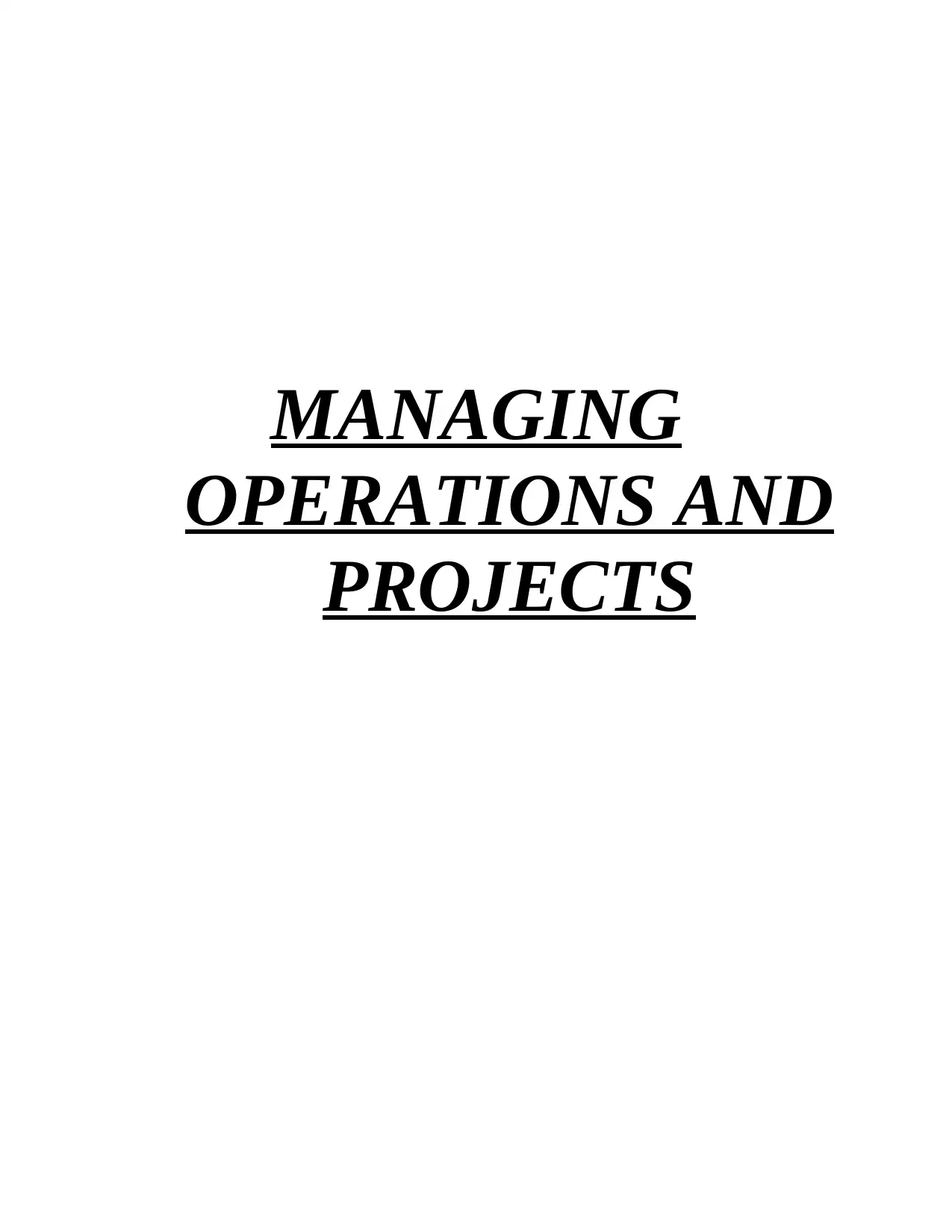
MANAGING
OPERATIONS AND
PROJECTS
OPERATIONS AND
PROJECTS
Paraphrase This Document
Need a fresh take? Get an instant paraphrase of this document with our AI Paraphraser
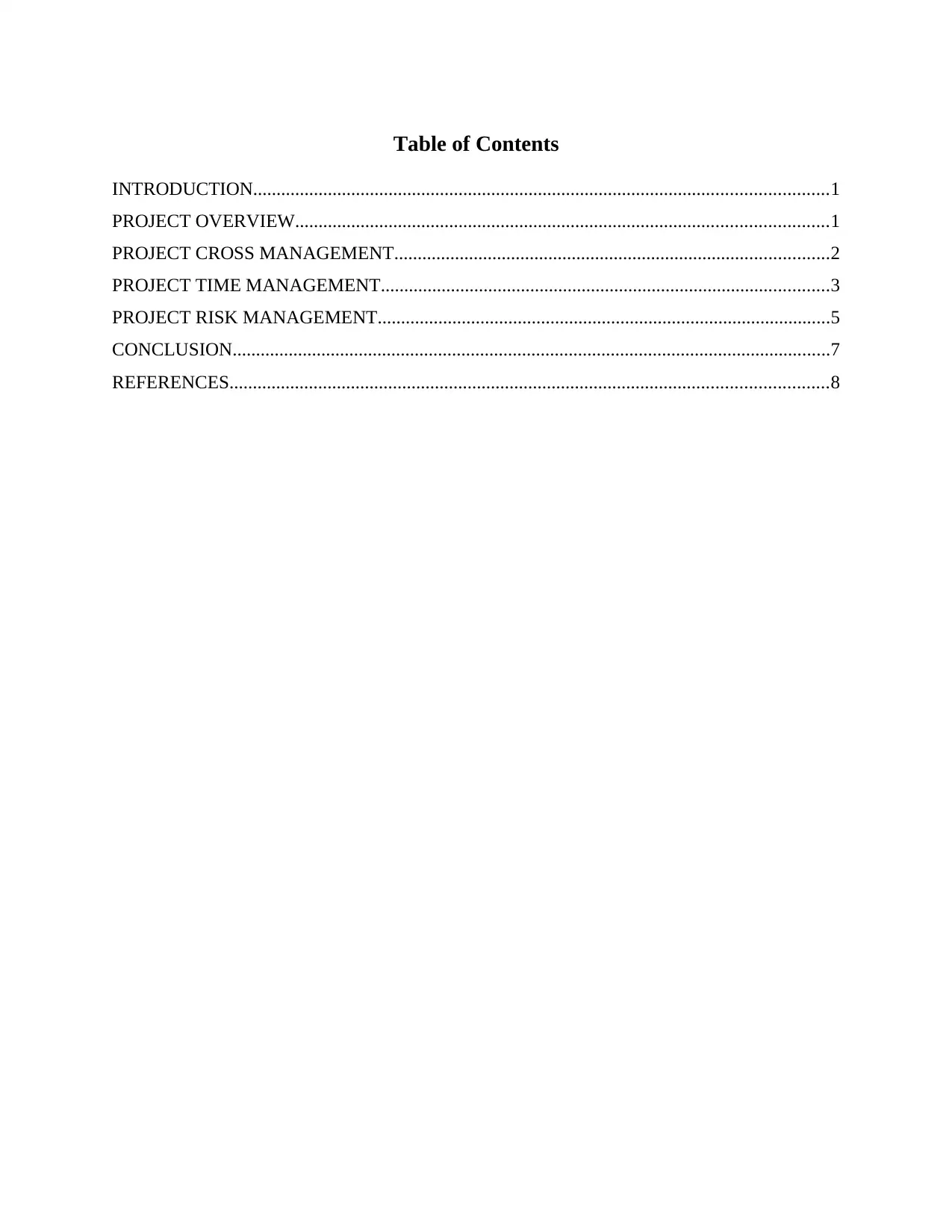
Table of Contents
INTRODUCTION...........................................................................................................................1
PROJECT OVERVIEW..................................................................................................................1
PROJECT CROSS MANAGEMENT.............................................................................................2
PROJECT TIME MANAGEMENT................................................................................................3
PROJECT RISK MANAGEMENT.................................................................................................5
CONCLUSION................................................................................................................................7
REFERENCES................................................................................................................................8
INTRODUCTION...........................................................................................................................1
PROJECT OVERVIEW..................................................................................................................1
PROJECT CROSS MANAGEMENT.............................................................................................2
PROJECT TIME MANAGEMENT................................................................................................3
PROJECT RISK MANAGEMENT.................................................................................................5
CONCLUSION................................................................................................................................7
REFERENCES................................................................................................................................8
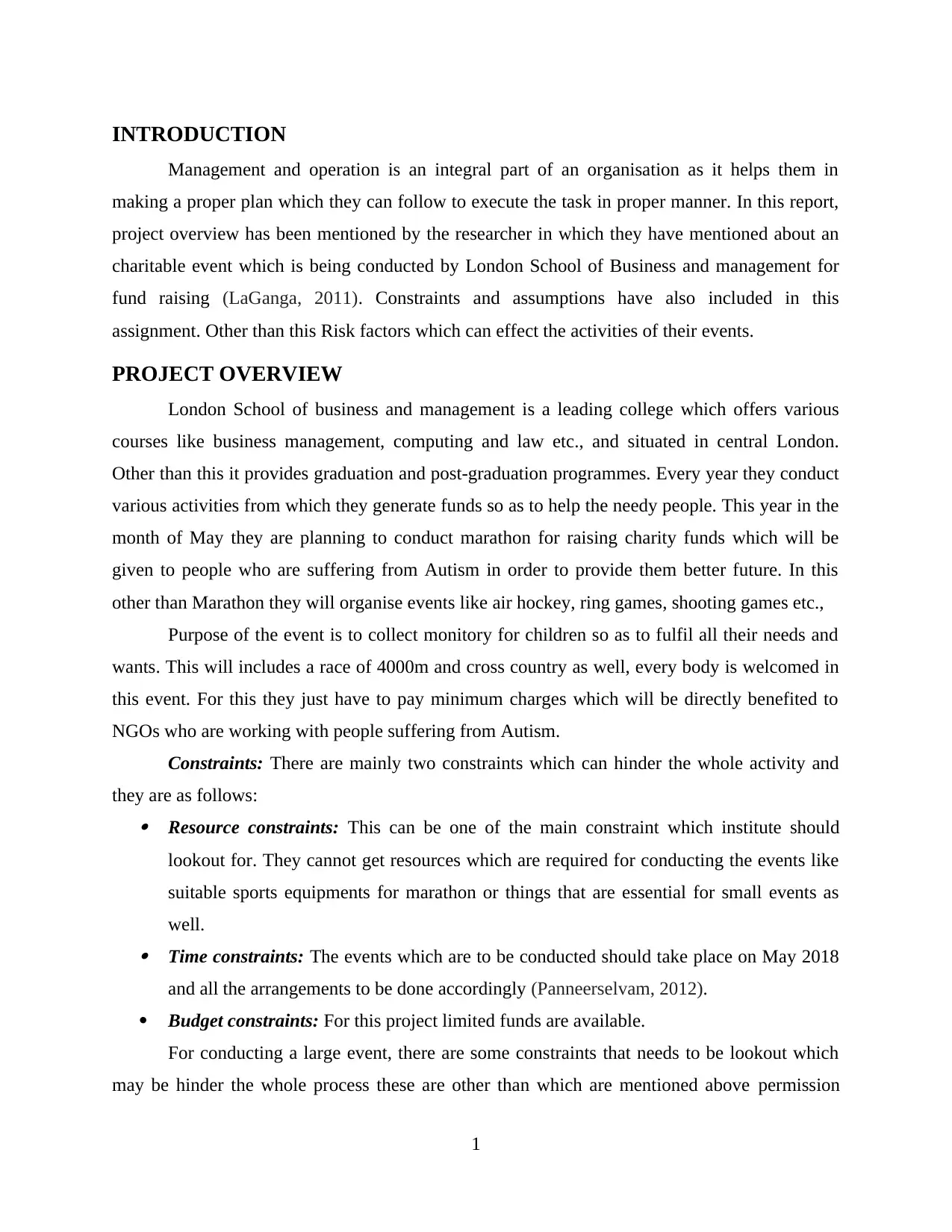
INTRODUCTION
Management and operation is an integral part of an organisation as it helps them in
making a proper plan which they can follow to execute the task in proper manner. In this report,
project overview has been mentioned by the researcher in which they have mentioned about an
charitable event which is being conducted by London School of Business and management for
fund raising (LaGanga, 2011). Constraints and assumptions have also included in this
assignment. Other than this Risk factors which can effect the activities of their events.
PROJECT OVERVIEW
London School of business and management is a leading college which offers various
courses like business management, computing and law etc., and situated in central London.
Other than this it provides graduation and post-graduation programmes. Every year they conduct
various activities from which they generate funds so as to help the needy people. This year in the
month of May they are planning to conduct marathon for raising charity funds which will be
given to people who are suffering from Autism in order to provide them better future. In this
other than Marathon they will organise events like air hockey, ring games, shooting games etc.,
Purpose of the event is to collect monitory for children so as to fulfil all their needs and
wants. This will includes a race of 4000m and cross country as well, every body is welcomed in
this event. For this they just have to pay minimum charges which will be directly benefited to
NGOs who are working with people suffering from Autism.
Constraints: There are mainly two constraints which can hinder the whole activity and
they are as follows: Resource constraints: This can be one of the main constraint which institute should
lookout for. They cannot get resources which are required for conducting the events like
suitable sports equipments for marathon or things that are essential for small events as
well. Time constraints: The events which are to be conducted should take place on May 2018
and all the arrangements to be done accordingly (Panneerselvam, 2012).
Budget constraints: For this project limited funds are available.
For conducting a large event, there are some constraints that needs to be lookout which
may be hinder the whole process these are other than which are mentioned above permission
1
Management and operation is an integral part of an organisation as it helps them in
making a proper plan which they can follow to execute the task in proper manner. In this report,
project overview has been mentioned by the researcher in which they have mentioned about an
charitable event which is being conducted by London School of Business and management for
fund raising (LaGanga, 2011). Constraints and assumptions have also included in this
assignment. Other than this Risk factors which can effect the activities of their events.
PROJECT OVERVIEW
London School of business and management is a leading college which offers various
courses like business management, computing and law etc., and situated in central London.
Other than this it provides graduation and post-graduation programmes. Every year they conduct
various activities from which they generate funds so as to help the needy people. This year in the
month of May they are planning to conduct marathon for raising charity funds which will be
given to people who are suffering from Autism in order to provide them better future. In this
other than Marathon they will organise events like air hockey, ring games, shooting games etc.,
Purpose of the event is to collect monitory for children so as to fulfil all their needs and
wants. This will includes a race of 4000m and cross country as well, every body is welcomed in
this event. For this they just have to pay minimum charges which will be directly benefited to
NGOs who are working with people suffering from Autism.
Constraints: There are mainly two constraints which can hinder the whole activity and
they are as follows: Resource constraints: This can be one of the main constraint which institute should
lookout for. They cannot get resources which are required for conducting the events like
suitable sports equipments for marathon or things that are essential for small events as
well. Time constraints: The events which are to be conducted should take place on May 2018
and all the arrangements to be done accordingly (Panneerselvam, 2012).
Budget constraints: For this project limited funds are available.
For conducting a large event, there are some constraints that needs to be lookout which
may be hinder the whole process these are other than which are mentioned above permission
1
⊘ This is a preview!⊘
Do you want full access?
Subscribe today to unlock all pages.

Trusted by 1+ million students worldwide
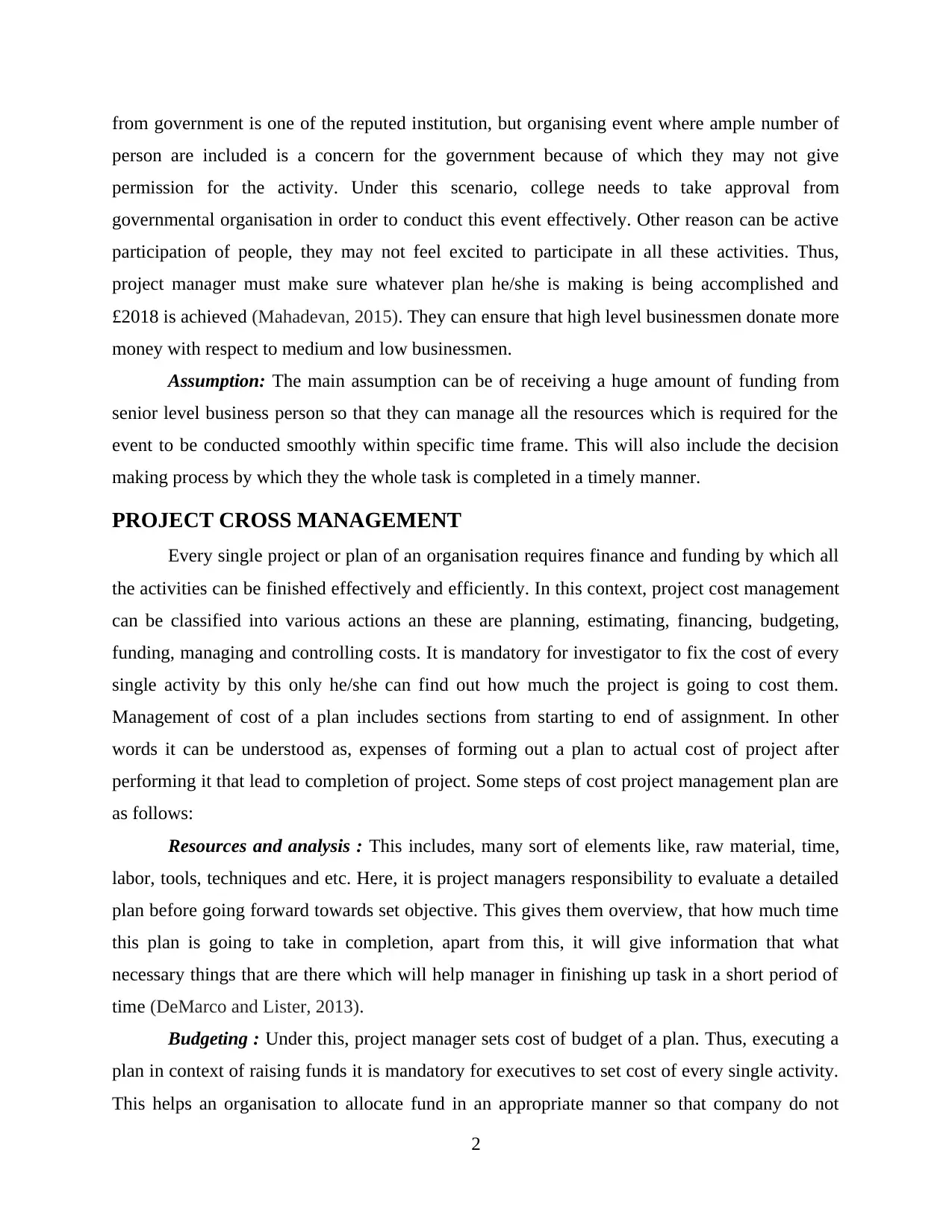
from government is one of the reputed institution, but organising event where ample number of
person are included is a concern for the government because of which they may not give
permission for the activity. Under this scenario, college needs to take approval from
governmental organisation in order to conduct this event effectively. Other reason can be active
participation of people, they may not feel excited to participate in all these activities. Thus,
project manager must make sure whatever plan he/she is making is being accomplished and
£2018 is achieved (Mahadevan, 2015). They can ensure that high level businessmen donate more
money with respect to medium and low businessmen.
Assumption: The main assumption can be of receiving a huge amount of funding from
senior level business person so that they can manage all the resources which is required for the
event to be conducted smoothly within specific time frame. This will also include the decision
making process by which they the whole task is completed in a timely manner.
PROJECT CROSS MANAGEMENT
Every single project or plan of an organisation requires finance and funding by which all
the activities can be finished effectively and efficiently. In this context, project cost management
can be classified into various actions an these are planning, estimating, financing, budgeting,
funding, managing and controlling costs. It is mandatory for investigator to fix the cost of every
single activity by this only he/she can find out how much the project is going to cost them.
Management of cost of a plan includes sections from starting to end of assignment. In other
words it can be understood as, expenses of forming out a plan to actual cost of project after
performing it that lead to completion of project. Some steps of cost project management plan are
as follows:
Resources and analysis : This includes, many sort of elements like, raw material, time,
labor, tools, techniques and etc. Here, it is project managers responsibility to evaluate a detailed
plan before going forward towards set objective. This gives them overview, that how much time
this plan is going to take in completion, apart from this, it will give information that what
necessary things that are there which will help manager in finishing up task in a short period of
time (DeMarco and Lister, 2013).
Budgeting : Under this, project manager sets cost of budget of a plan. Thus, executing a
plan in context of raising funds it is mandatory for executives to set cost of every single activity.
This helps an organisation to allocate fund in an appropriate manner so that company do not
2
person are included is a concern for the government because of which they may not give
permission for the activity. Under this scenario, college needs to take approval from
governmental organisation in order to conduct this event effectively. Other reason can be active
participation of people, they may not feel excited to participate in all these activities. Thus,
project manager must make sure whatever plan he/she is making is being accomplished and
£2018 is achieved (Mahadevan, 2015). They can ensure that high level businessmen donate more
money with respect to medium and low businessmen.
Assumption: The main assumption can be of receiving a huge amount of funding from
senior level business person so that they can manage all the resources which is required for the
event to be conducted smoothly within specific time frame. This will also include the decision
making process by which they the whole task is completed in a timely manner.
PROJECT CROSS MANAGEMENT
Every single project or plan of an organisation requires finance and funding by which all
the activities can be finished effectively and efficiently. In this context, project cost management
can be classified into various actions an these are planning, estimating, financing, budgeting,
funding, managing and controlling costs. It is mandatory for investigator to fix the cost of every
single activity by this only he/she can find out how much the project is going to cost them.
Management of cost of a plan includes sections from starting to end of assignment. In other
words it can be understood as, expenses of forming out a plan to actual cost of project after
performing it that lead to completion of project. Some steps of cost project management plan are
as follows:
Resources and analysis : This includes, many sort of elements like, raw material, time,
labor, tools, techniques and etc. Here, it is project managers responsibility to evaluate a detailed
plan before going forward towards set objective. This gives them overview, that how much time
this plan is going to take in completion, apart from this, it will give information that what
necessary things that are there which will help manager in finishing up task in a short period of
time (DeMarco and Lister, 2013).
Budgeting : Under this, project manager sets cost of budget of a plan. Thus, executing a
plan in context of raising funds it is mandatory for executives to set cost of every single activity.
This helps an organisation to allocate fund in an appropriate manner so that company do not
2
Paraphrase This Document
Need a fresh take? Get an instant paraphrase of this document with our AI Paraphraser
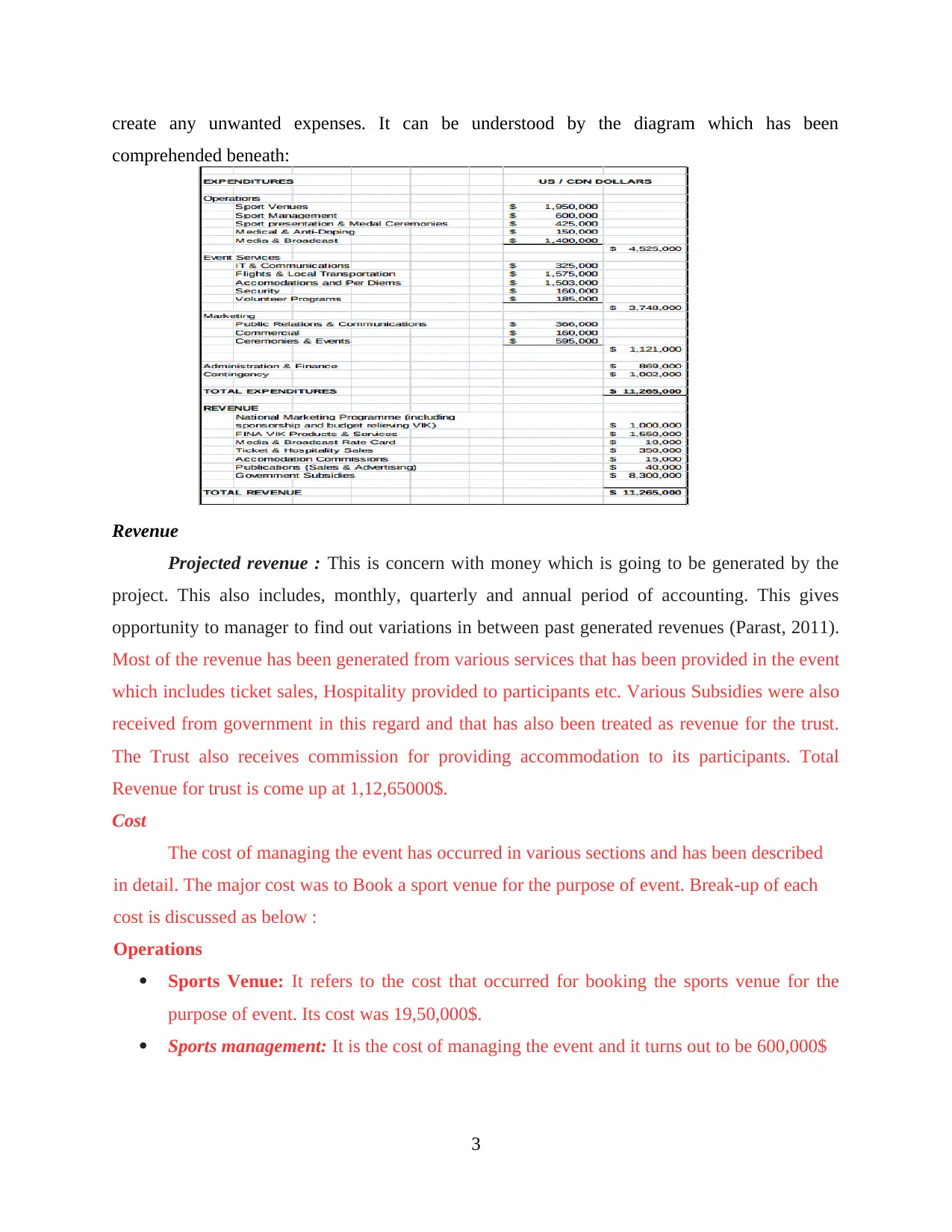
create any unwanted expenses. It can be understood by the diagram which has been
comprehended beneath:
Revenue
Projected revenue : This is concern with money which is going to be generated by the
project. This also includes, monthly, quarterly and annual period of accounting. This gives
opportunity to manager to find out variations in between past generated revenues (Parast, 2011).
Most of the revenue has been generated from various services that has been provided in the event
which includes ticket sales, Hospitality provided to participants etc. Various Subsidies were also
received from government in this regard and that has also been treated as revenue for the trust.
The Trust also receives commission for providing accommodation to its participants. Total
Revenue for trust is come up at 1,12,65000$.
Cost
The cost of managing the event has occurred in various sections and has been described
in detail. The major cost was to Book a sport venue for the purpose of event. Break-up of each
cost is discussed as below :
Operations
Sports Venue: It refers to the cost that occurred for booking the sports venue for the
purpose of event. Its cost was 19,50,000$.
Sports management: It is the cost of managing the event and it turns out to be 600,000$
3
comprehended beneath:
Revenue
Projected revenue : This is concern with money which is going to be generated by the
project. This also includes, monthly, quarterly and annual period of accounting. This gives
opportunity to manager to find out variations in between past generated revenues (Parast, 2011).
Most of the revenue has been generated from various services that has been provided in the event
which includes ticket sales, Hospitality provided to participants etc. Various Subsidies were also
received from government in this regard and that has also been treated as revenue for the trust.
The Trust also receives commission for providing accommodation to its participants. Total
Revenue for trust is come up at 1,12,65000$.
Cost
The cost of managing the event has occurred in various sections and has been described
in detail. The major cost was to Book a sport venue for the purpose of event. Break-up of each
cost is discussed as below :
Operations
Sports Venue: It refers to the cost that occurred for booking the sports venue for the
purpose of event. Its cost was 19,50,000$.
Sports management: It is the cost of managing the event and it turns out to be 600,000$
3
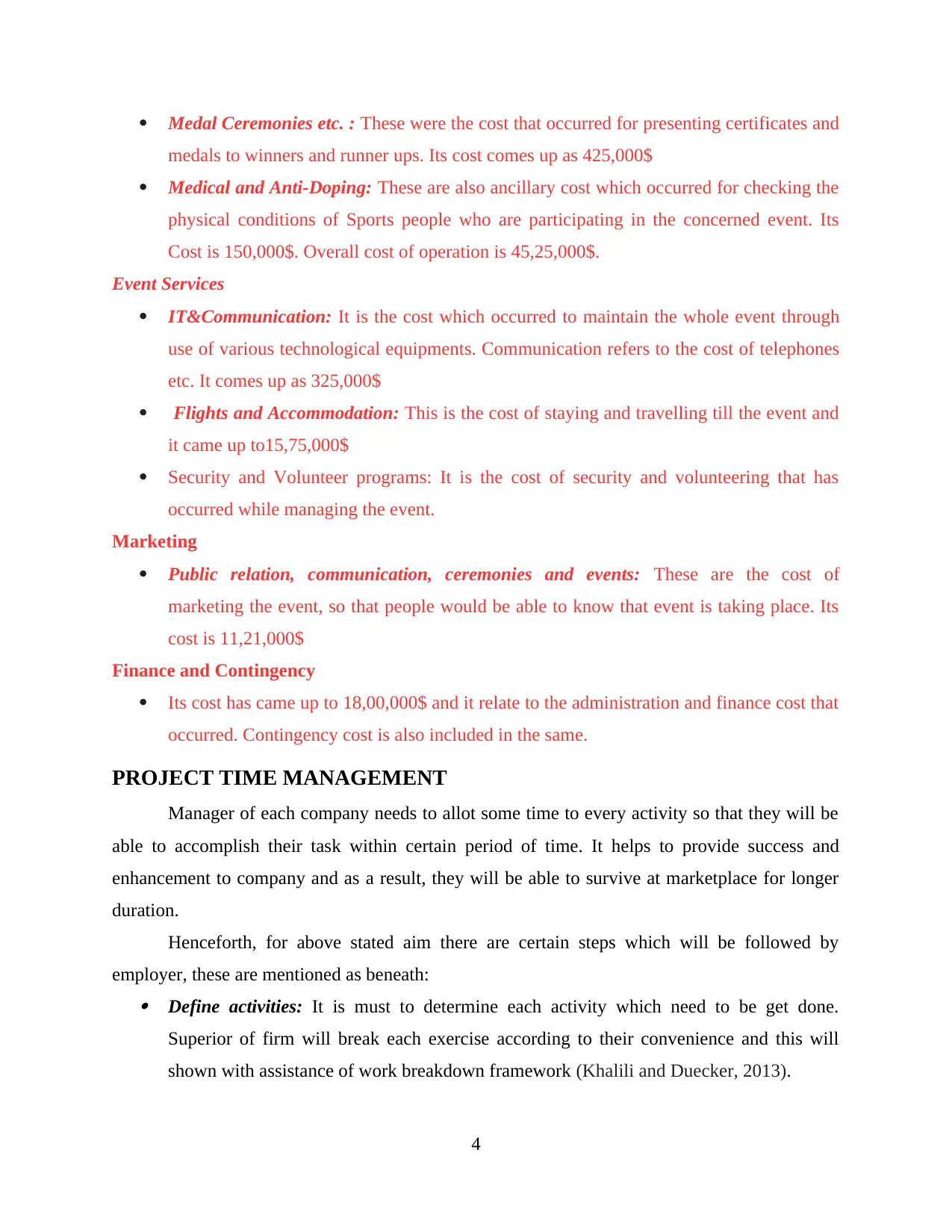
Medal Ceremonies etc. : These were the cost that occurred for presenting certificates and
medals to winners and runner ups. Its cost comes up as 425,000$
Medical and Anti-Doping: These are also ancillary cost which occurred for checking the
physical conditions of Sports people who are participating in the concerned event. Its
Cost is 150,000$. Overall cost of operation is 45,25,000$.
Event Services
IT&Communication: It is the cost which occurred to maintain the whole event through
use of various technological equipments. Communication refers to the cost of telephones
etc. It comes up as 325,000$
Flights and Accommodation: This is the cost of staying and travelling till the event and
it came up to15,75,000$
Security and Volunteer programs: It is the cost of security and volunteering that has
occurred while managing the event.
Marketing
Public relation, communication, ceremonies and events: These are the cost of
marketing the event, so that people would be able to know that event is taking place. Its
cost is 11,21,000$
Finance and Contingency
Its cost has came up to 18,00,000$ and it relate to the administration and finance cost that
occurred. Contingency cost is also included in the same.
PROJECT TIME MANAGEMENT
Manager of each company needs to allot some time to every activity so that they will be
able to accomplish their task within certain period of time. It helps to provide success and
enhancement to company and as a result, they will be able to survive at marketplace for longer
duration.
Henceforth, for above stated aim there are certain steps which will be followed by
employer, these are mentioned as beneath: Define activities: It is must to determine each activity which need to be get done.
Superior of firm will break each exercise according to their convenience and this will
shown with assistance of work breakdown framework (Khalili and Duecker, 2013).
4
medals to winners and runner ups. Its cost comes up as 425,000$
Medical and Anti-Doping: These are also ancillary cost which occurred for checking the
physical conditions of Sports people who are participating in the concerned event. Its
Cost is 150,000$. Overall cost of operation is 45,25,000$.
Event Services
IT&Communication: It is the cost which occurred to maintain the whole event through
use of various technological equipments. Communication refers to the cost of telephones
etc. It comes up as 325,000$
Flights and Accommodation: This is the cost of staying and travelling till the event and
it came up to15,75,000$
Security and Volunteer programs: It is the cost of security and volunteering that has
occurred while managing the event.
Marketing
Public relation, communication, ceremonies and events: These are the cost of
marketing the event, so that people would be able to know that event is taking place. Its
cost is 11,21,000$
Finance and Contingency
Its cost has came up to 18,00,000$ and it relate to the administration and finance cost that
occurred. Contingency cost is also included in the same.
PROJECT TIME MANAGEMENT
Manager of each company needs to allot some time to every activity so that they will be
able to accomplish their task within certain period of time. It helps to provide success and
enhancement to company and as a result, they will be able to survive at marketplace for longer
duration.
Henceforth, for above stated aim there are certain steps which will be followed by
employer, these are mentioned as beneath: Define activities: It is must to determine each activity which need to be get done.
Superior of firm will break each exercise according to their convenience and this will
shown with assistance of work breakdown framework (Khalili and Duecker, 2013).
4
⊘ This is a preview!⊘
Do you want full access?
Subscribe today to unlock all pages.

Trusted by 1+ million students worldwide
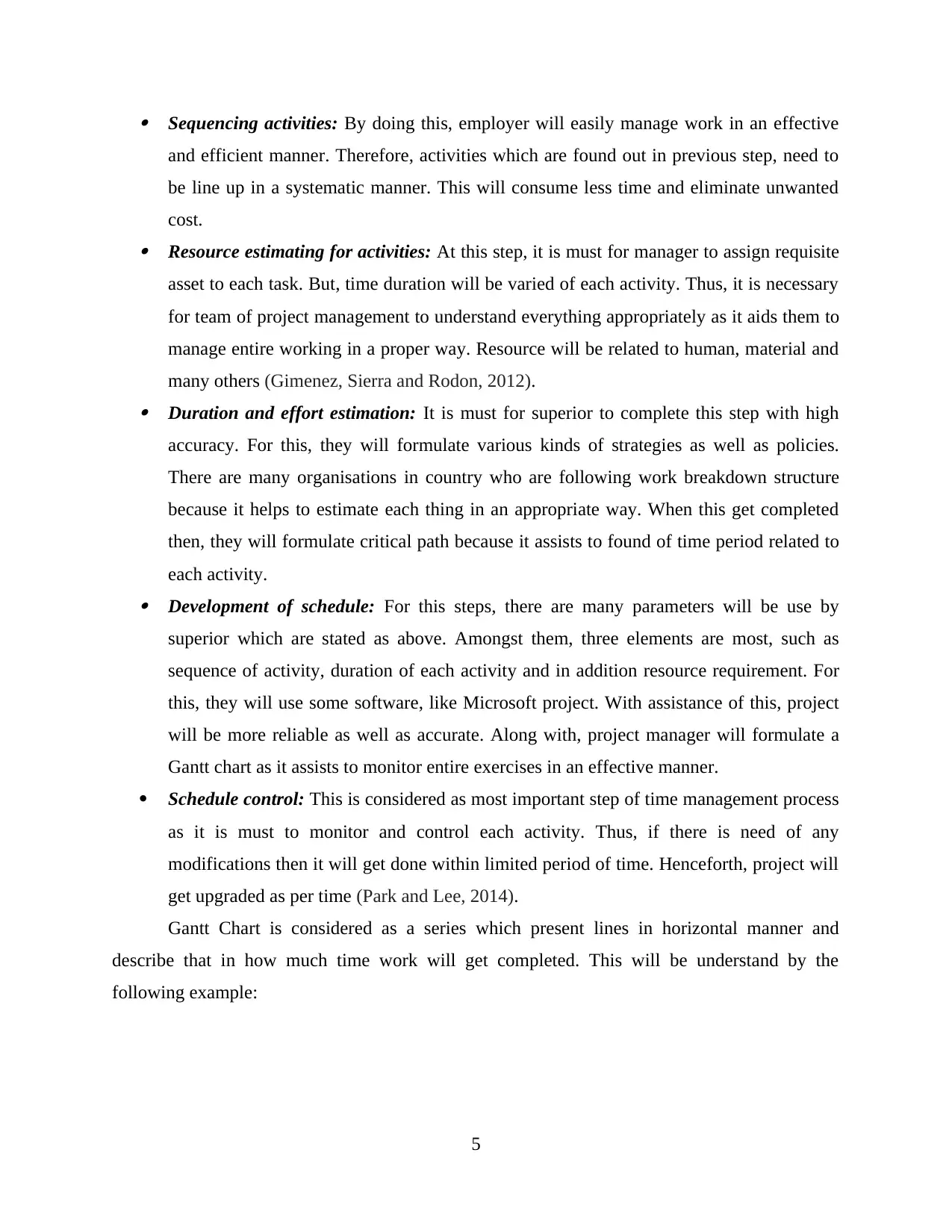
Sequencing activities: By doing this, employer will easily manage work in an effective
and efficient manner. Therefore, activities which are found out in previous step, need to
be line up in a systematic manner. This will consume less time and eliminate unwanted
cost. Resource estimating for activities: At this step, it is must for manager to assign requisite
asset to each task. But, time duration will be varied of each activity. Thus, it is necessary
for team of project management to understand everything appropriately as it aids them to
manage entire working in a proper way. Resource will be related to human, material and
many others (Gimenez, Sierra and Rodon, 2012). Duration and effort estimation: It is must for superior to complete this step with high
accuracy. For this, they will formulate various kinds of strategies as well as policies.
There are many organisations in country who are following work breakdown structure
because it helps to estimate each thing in an appropriate way. When this get completed
then, they will formulate critical path because it assists to found of time period related to
each activity. Development of schedule: For this steps, there are many parameters will be use by
superior which are stated as above. Amongst them, three elements are most, such as
sequence of activity, duration of each activity and in addition resource requirement. For
this, they will use some software, like Microsoft project. With assistance of this, project
will be more reliable as well as accurate. Along with, project manager will formulate a
Gantt chart as it assists to monitor entire exercises in an effective manner.
Schedule control: This is considered as most important step of time management process
as it is must to monitor and control each activity. Thus, if there is need of any
modifications then it will get done within limited period of time. Henceforth, project will
get upgraded as per time (Park and Lee, 2014).
Gantt Chart is considered as a series which present lines in horizontal manner and
describe that in how much time work will get completed. This will be understand by the
following example:
5
and efficient manner. Therefore, activities which are found out in previous step, need to
be line up in a systematic manner. This will consume less time and eliminate unwanted
cost. Resource estimating for activities: At this step, it is must for manager to assign requisite
asset to each task. But, time duration will be varied of each activity. Thus, it is necessary
for team of project management to understand everything appropriately as it aids them to
manage entire working in a proper way. Resource will be related to human, material and
many others (Gimenez, Sierra and Rodon, 2012). Duration and effort estimation: It is must for superior to complete this step with high
accuracy. For this, they will formulate various kinds of strategies as well as policies.
There are many organisations in country who are following work breakdown structure
because it helps to estimate each thing in an appropriate way. When this get completed
then, they will formulate critical path because it assists to found of time period related to
each activity. Development of schedule: For this steps, there are many parameters will be use by
superior which are stated as above. Amongst them, three elements are most, such as
sequence of activity, duration of each activity and in addition resource requirement. For
this, they will use some software, like Microsoft project. With assistance of this, project
will be more reliable as well as accurate. Along with, project manager will formulate a
Gantt chart as it assists to monitor entire exercises in an effective manner.
Schedule control: This is considered as most important step of time management process
as it is must to monitor and control each activity. Thus, if there is need of any
modifications then it will get done within limited period of time. Henceforth, project will
get upgraded as per time (Park and Lee, 2014).
Gantt Chart is considered as a series which present lines in horizontal manner and
describe that in how much time work will get completed. This will be understand by the
following example:
5
Paraphrase This Document
Need a fresh take? Get an instant paraphrase of this document with our AI Paraphraser
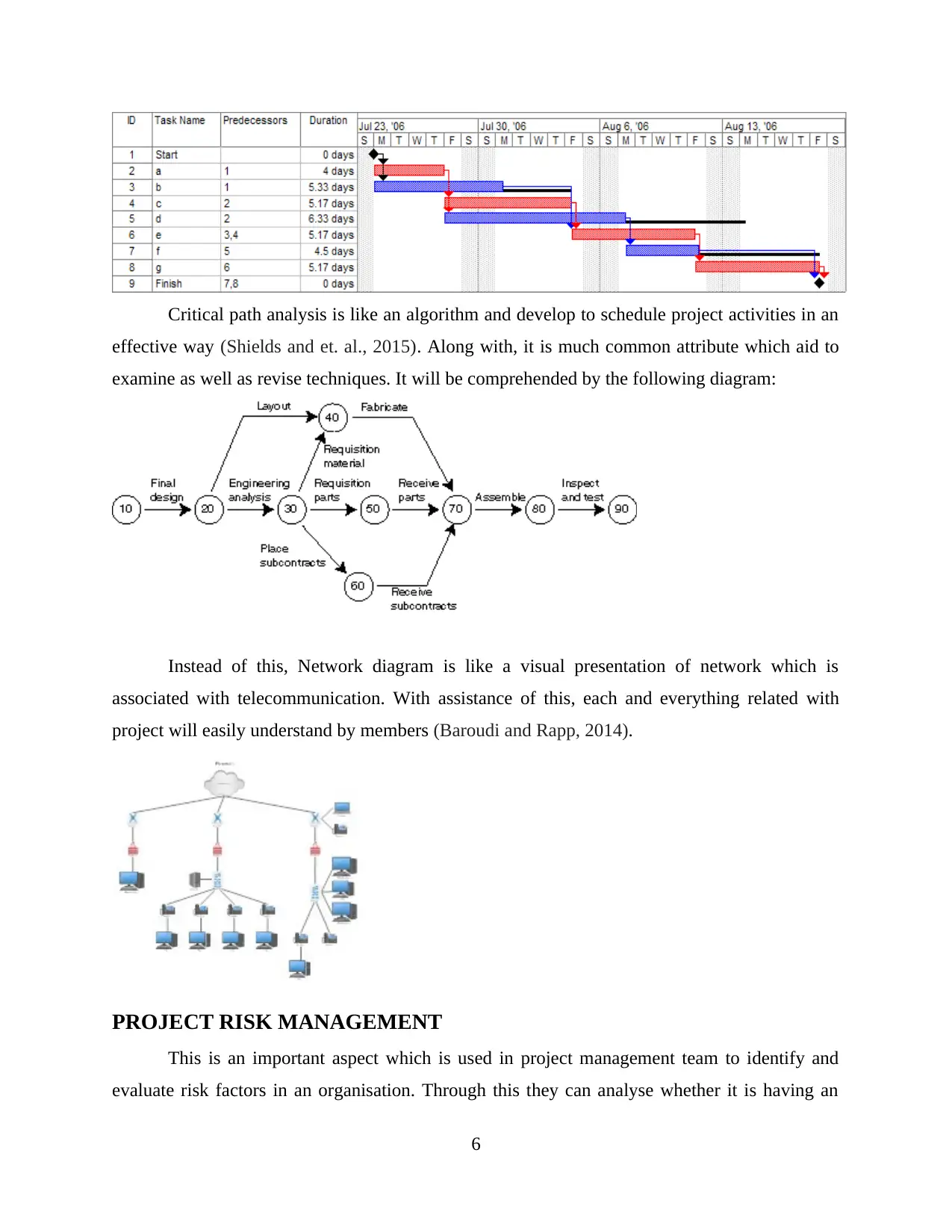
Critical path analysis is like an algorithm and develop to schedule project activities in an
effective way (Shields and et. al., 2015). Along with, it is much common attribute which aid to
examine as well as revise techniques. It will be comprehended by the following diagram:
Instead of this, Network diagram is like a visual presentation of network which is
associated with telecommunication. With assistance of this, each and everything related with
project will easily understand by members (Baroudi and Rapp, 2014).
PROJECT RISK MANAGEMENT
This is an important aspect which is used in project management team to identify and
evaluate risk factors in an organisation. Through this they can analyse whether it is having an
6
effective way (Shields and et. al., 2015). Along with, it is much common attribute which aid to
examine as well as revise techniques. It will be comprehended by the following diagram:
Instead of this, Network diagram is like a visual presentation of network which is
associated with telecommunication. With assistance of this, each and everything related with
project will easily understand by members (Baroudi and Rapp, 2014).
PROJECT RISK MANAGEMENT
This is an important aspect which is used in project management team to identify and
evaluate risk factors in an organisation. Through this they can analyse whether it is having an
6
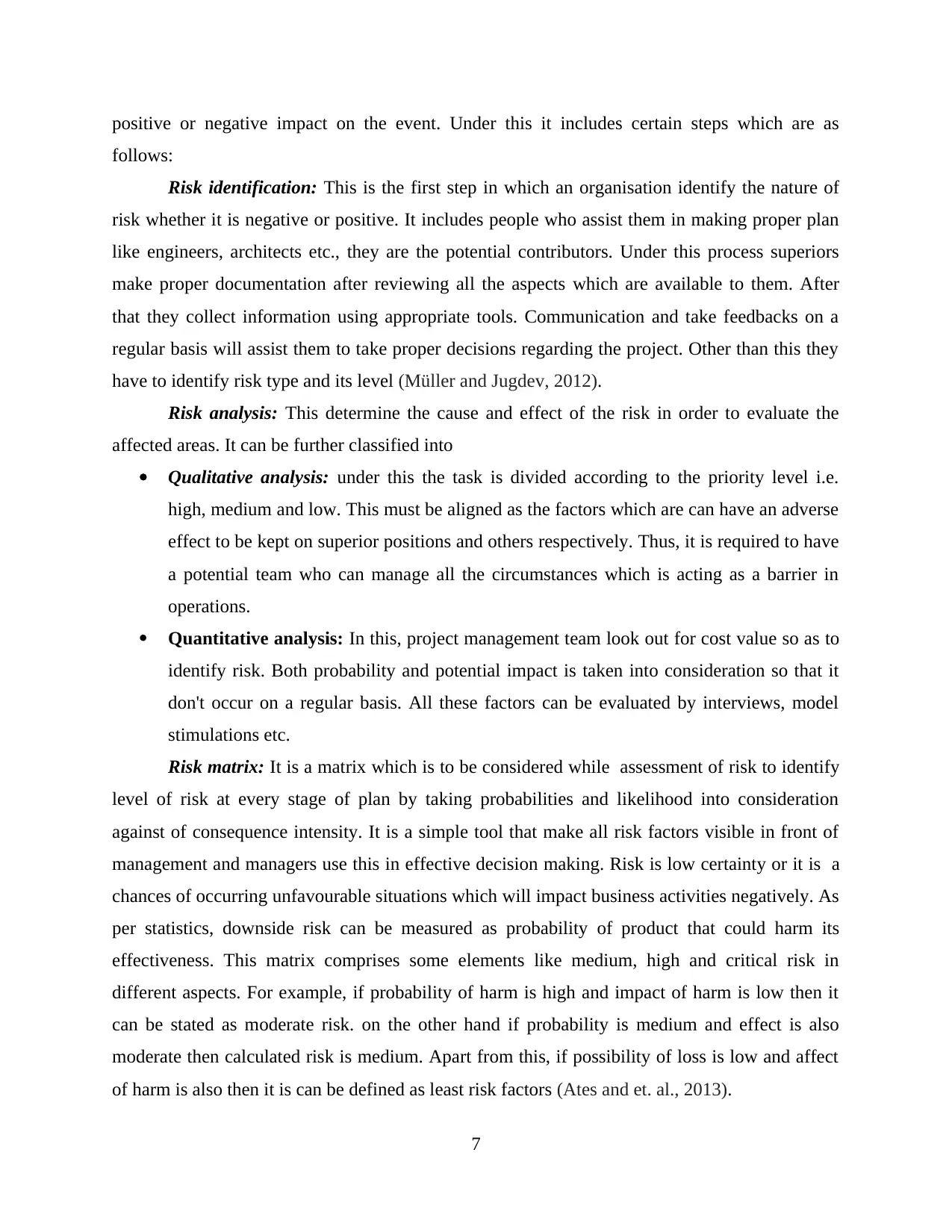
positive or negative impact on the event. Under this it includes certain steps which are as
follows:
Risk identification: This is the first step in which an organisation identify the nature of
risk whether it is negative or positive. It includes people who assist them in making proper plan
like engineers, architects etc., they are the potential contributors. Under this process superiors
make proper documentation after reviewing all the aspects which are available to them. After
that they collect information using appropriate tools. Communication and take feedbacks on a
regular basis will assist them to take proper decisions regarding the project. Other than this they
have to identify risk type and its level (Müller and Jugdev, 2012).
Risk analysis: This determine the cause and effect of the risk in order to evaluate the
affected areas. It can be further classified into
Qualitative analysis: under this the task is divided according to the priority level i.e.
high, medium and low. This must be aligned as the factors which are can have an adverse
effect to be kept on superior positions and others respectively. Thus, it is required to have
a potential team who can manage all the circumstances which is acting as a barrier in
operations.
Quantitative analysis: In this, project management team look out for cost value so as to
identify risk. Both probability and potential impact is taken into consideration so that it
don't occur on a regular basis. All these factors can be evaluated by interviews, model
stimulations etc.
Risk matrix: It is a matrix which is to be considered while assessment of risk to identify
level of risk at every stage of plan by taking probabilities and likelihood into consideration
against of consequence intensity. It is a simple tool that make all risk factors visible in front of
management and managers use this in effective decision making. Risk is low certainty or it is a
chances of occurring unfavourable situations which will impact business activities negatively. As
per statistics, downside risk can be measured as probability of product that could harm its
effectiveness. This matrix comprises some elements like medium, high and critical risk in
different aspects. For example, if probability of harm is high and impact of harm is low then it
can be stated as moderate risk. on the other hand if probability is medium and effect is also
moderate then calculated risk is medium. Apart from this, if possibility of loss is low and affect
of harm is also then it is can be defined as least risk factors (Ates and et. al., 2013).
7
follows:
Risk identification: This is the first step in which an organisation identify the nature of
risk whether it is negative or positive. It includes people who assist them in making proper plan
like engineers, architects etc., they are the potential contributors. Under this process superiors
make proper documentation after reviewing all the aspects which are available to them. After
that they collect information using appropriate tools. Communication and take feedbacks on a
regular basis will assist them to take proper decisions regarding the project. Other than this they
have to identify risk type and its level (Müller and Jugdev, 2012).
Risk analysis: This determine the cause and effect of the risk in order to evaluate the
affected areas. It can be further classified into
Qualitative analysis: under this the task is divided according to the priority level i.e.
high, medium and low. This must be aligned as the factors which are can have an adverse
effect to be kept on superior positions and others respectively. Thus, it is required to have
a potential team who can manage all the circumstances which is acting as a barrier in
operations.
Quantitative analysis: In this, project management team look out for cost value so as to
identify risk. Both probability and potential impact is taken into consideration so that it
don't occur on a regular basis. All these factors can be evaluated by interviews, model
stimulations etc.
Risk matrix: It is a matrix which is to be considered while assessment of risk to identify
level of risk at every stage of plan by taking probabilities and likelihood into consideration
against of consequence intensity. It is a simple tool that make all risk factors visible in front of
management and managers use this in effective decision making. Risk is low certainty or it is a
chances of occurring unfavourable situations which will impact business activities negatively. As
per statistics, downside risk can be measured as probability of product that could harm its
effectiveness. This matrix comprises some elements like medium, high and critical risk in
different aspects. For example, if probability of harm is high and impact of harm is low then it
can be stated as moderate risk. on the other hand if probability is medium and effect is also
moderate then calculated risk is medium. Apart from this, if possibility of loss is low and affect
of harm is also then it is can be defined as least risk factors (Ates and et. al., 2013).
7
⊘ This is a preview!⊘
Do you want full access?
Subscribe today to unlock all pages.

Trusted by 1+ million students worldwide
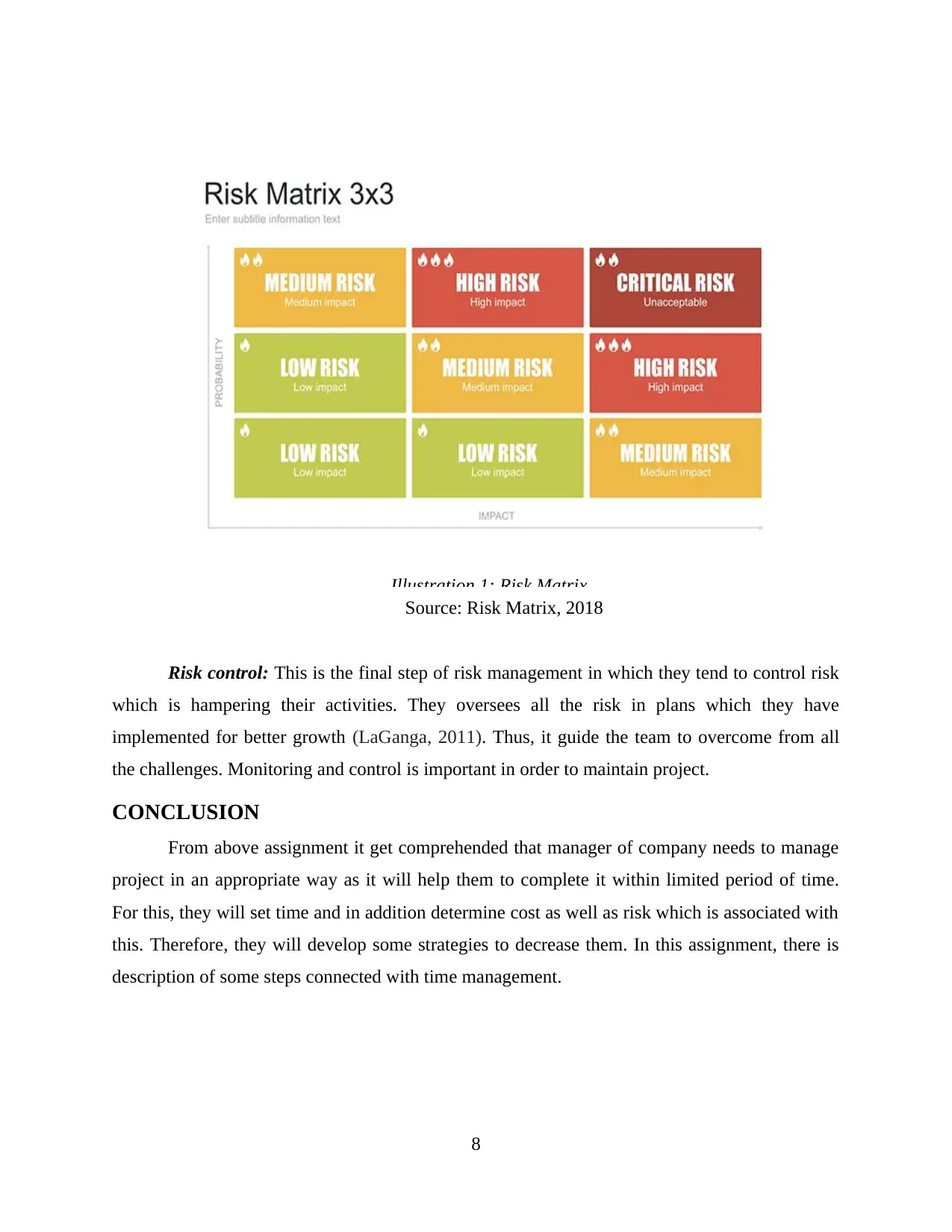
Source: Risk Matrix, 2018
Risk control: This is the final step of risk management in which they tend to control risk
which is hampering their activities. They oversees all the risk in plans which they have
implemented for better growth (LaGanga, 2011). Thus, it guide the team to overcome from all
the challenges. Monitoring and control is important in order to maintain project.
CONCLUSION
From above assignment it get comprehended that manager of company needs to manage
project in an appropriate way as it will help them to complete it within limited period of time.
For this, they will set time and in addition determine cost as well as risk which is associated with
this. Therefore, they will develop some strategies to decrease them. In this assignment, there is
description of some steps connected with time management.
8
Illustration 1: Risk Matrix
Risk control: This is the final step of risk management in which they tend to control risk
which is hampering their activities. They oversees all the risk in plans which they have
implemented for better growth (LaGanga, 2011). Thus, it guide the team to overcome from all
the challenges. Monitoring and control is important in order to maintain project.
CONCLUSION
From above assignment it get comprehended that manager of company needs to manage
project in an appropriate way as it will help them to complete it within limited period of time.
For this, they will set time and in addition determine cost as well as risk which is associated with
this. Therefore, they will develop some strategies to decrease them. In this assignment, there is
description of some steps connected with time management.
8
Illustration 1: Risk Matrix
Paraphrase This Document
Need a fresh take? Get an instant paraphrase of this document with our AI Paraphraser
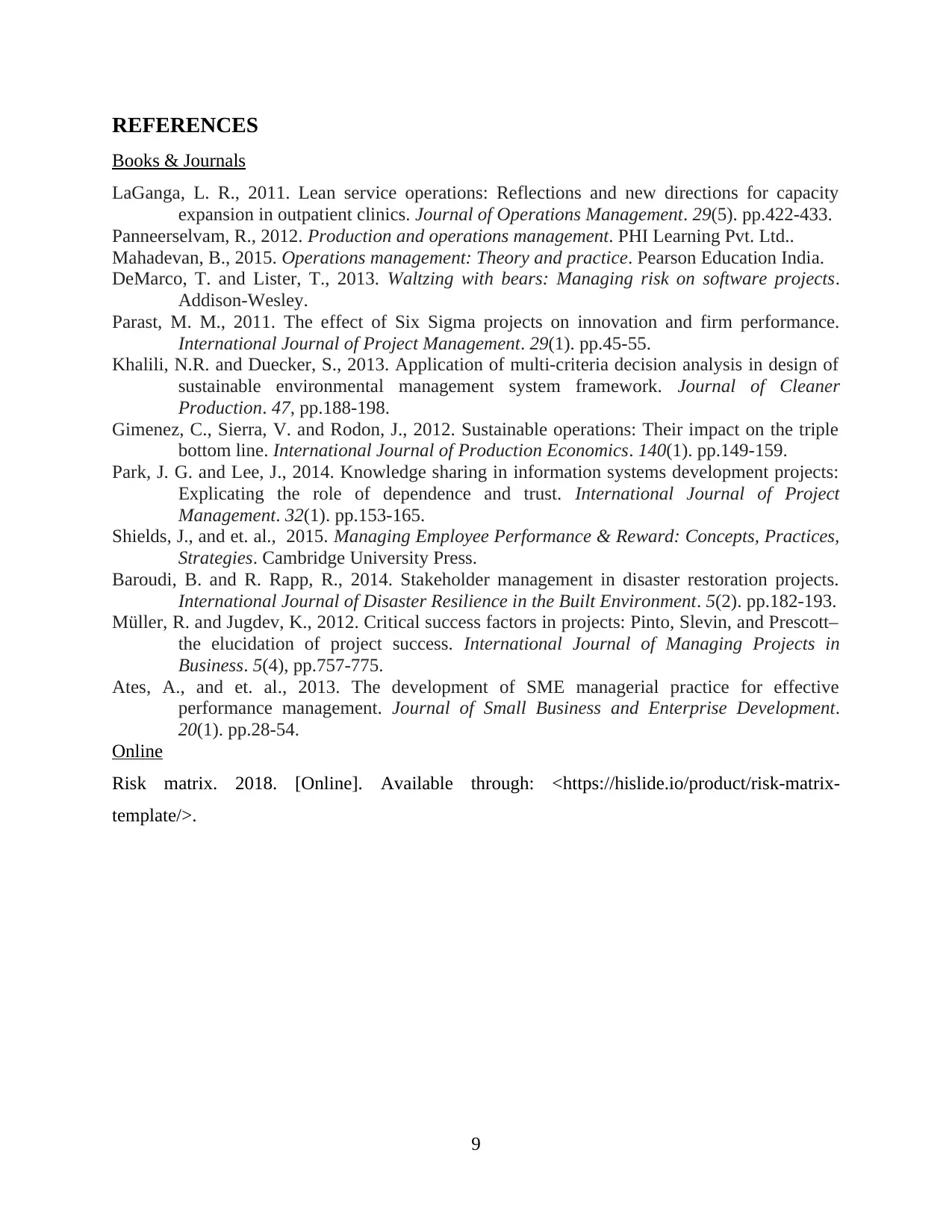
REFERENCES
Books & Journals
LaGanga, L. R., 2011. Lean service operations: Reflections and new directions for capacity
expansion in outpatient clinics. Journal of Operations Management. 29(5). pp.422-433.
Panneerselvam, R., 2012. Production and operations management. PHI Learning Pvt. Ltd..
Mahadevan, B., 2015. Operations management: Theory and practice. Pearson Education India.
DeMarco, T. and Lister, T., 2013. Waltzing with bears: Managing risk on software projects.
Addison-Wesley.
Parast, M. M., 2011. The effect of Six Sigma projects on innovation and firm performance.
International Journal of Project Management. 29(1). pp.45-55.
Khalili, N.R. and Duecker, S., 2013. Application of multi-criteria decision analysis in design of
sustainable environmental management system framework. Journal of Cleaner
Production. 47, pp.188-198.
Gimenez, C., Sierra, V. and Rodon, J., 2012. Sustainable operations: Their impact on the triple
bottom line. International Journal of Production Economics. 140(1). pp.149-159.
Park, J. G. and Lee, J., 2014. Knowledge sharing in information systems development projects:
Explicating the role of dependence and trust. International Journal of Project
Management. 32(1). pp.153-165.
Shields, J., and et. al., 2015. Managing Employee Performance & Reward: Concepts, Practices,
Strategies. Cambridge University Press.
Baroudi, B. and R. Rapp, R., 2014. Stakeholder management in disaster restoration projects.
International Journal of Disaster Resilience in the Built Environment. 5(2). pp.182-193.
Müller, R. and Jugdev, K., 2012. Critical success factors in projects: Pinto, Slevin, and Prescott–
the elucidation of project success. International Journal of Managing Projects in
Business. 5(4), pp.757-775.
Ates, A., and et. al., 2013. The development of SME managerial practice for effective
performance management. Journal of Small Business and Enterprise Development.
20(1). pp.28-54.
Online
Risk matrix. 2018. [Online]. Available through: <https://hislide.io/product/risk-matrix-
template/>.
9
Books & Journals
LaGanga, L. R., 2011. Lean service operations: Reflections and new directions for capacity
expansion in outpatient clinics. Journal of Operations Management. 29(5). pp.422-433.
Panneerselvam, R., 2012. Production and operations management. PHI Learning Pvt. Ltd..
Mahadevan, B., 2015. Operations management: Theory and practice. Pearson Education India.
DeMarco, T. and Lister, T., 2013. Waltzing with bears: Managing risk on software projects.
Addison-Wesley.
Parast, M. M., 2011. The effect of Six Sigma projects on innovation and firm performance.
International Journal of Project Management. 29(1). pp.45-55.
Khalili, N.R. and Duecker, S., 2013. Application of multi-criteria decision analysis in design of
sustainable environmental management system framework. Journal of Cleaner
Production. 47, pp.188-198.
Gimenez, C., Sierra, V. and Rodon, J., 2012. Sustainable operations: Their impact on the triple
bottom line. International Journal of Production Economics. 140(1). pp.149-159.
Park, J. G. and Lee, J., 2014. Knowledge sharing in information systems development projects:
Explicating the role of dependence and trust. International Journal of Project
Management. 32(1). pp.153-165.
Shields, J., and et. al., 2015. Managing Employee Performance & Reward: Concepts, Practices,
Strategies. Cambridge University Press.
Baroudi, B. and R. Rapp, R., 2014. Stakeholder management in disaster restoration projects.
International Journal of Disaster Resilience in the Built Environment. 5(2). pp.182-193.
Müller, R. and Jugdev, K., 2012. Critical success factors in projects: Pinto, Slevin, and Prescott–
the elucidation of project success. International Journal of Managing Projects in
Business. 5(4), pp.757-775.
Ates, A., and et. al., 2013. The development of SME managerial practice for effective
performance management. Journal of Small Business and Enterprise Development.
20(1). pp.28-54.
Online
Risk matrix. 2018. [Online]. Available through: <https://hislide.io/product/risk-matrix-
template/>.
9
1 out of 11
Related Documents
Your All-in-One AI-Powered Toolkit for Academic Success.
+13062052269
info@desklib.com
Available 24*7 on WhatsApp / Email
![[object Object]](/_next/static/media/star-bottom.7253800d.svg)
Unlock your academic potential
Copyright © 2020–2025 A2Z Services. All Rights Reserved. Developed and managed by ZUCOL.





